The Lascaux Cave Apse-Shaft Paintings – circa 17,000 B.P., Dordogne France:
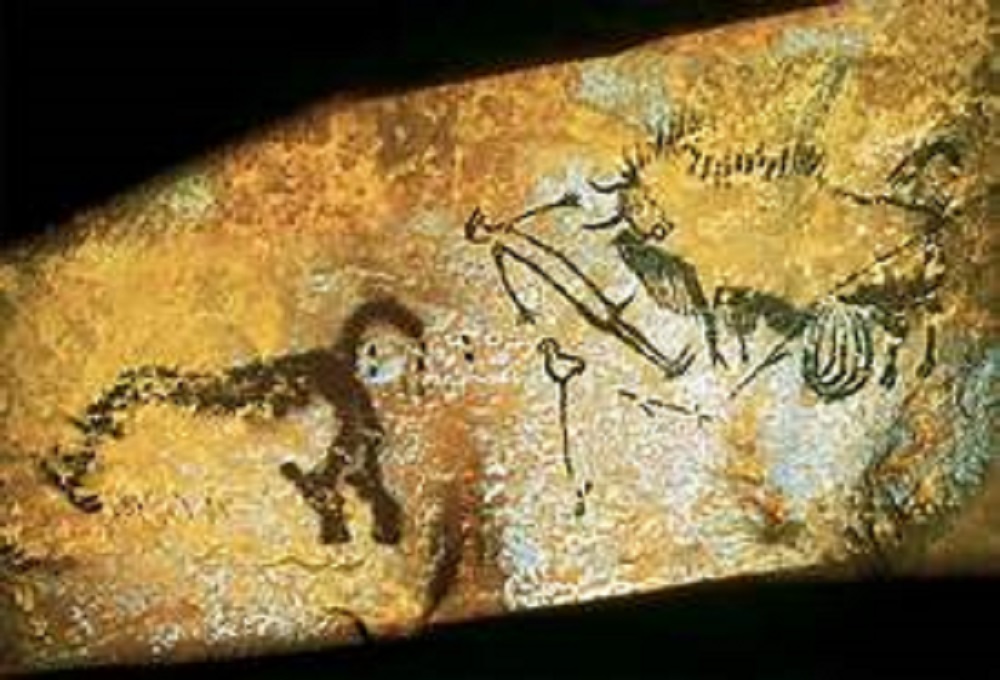
This photographic image from a rather inaccesible section of the Lascaux Cave (in a far end and down a 16 ft shaft), shows just 4 of the over 6,000 figures of animals and geometric designs that adorn the walls and ceilings throughout the Paleolithic Cave. There are no other humans depicted in the cave – only this stick figure – and no other birds. This is typical of all Paleolithic Cave Art, the paintings are almost all Ice-Age mammals – both prey and formidable carnivores, the hunted mammals in various poses: often wounded and bleeding. A few birds and fish are drawn here and there but almost no humans. Depicting themselves wasnt on their minds it seems. It isnt until well after 10,000yrs BP – on average 10-20,000 years later than most Paleolithic Art, that we see humans depicted regularly in all sorts of activities. This later Neolithic tribal art is incredibly different from the Paleolithic animal, hunting, and geometric images.
As in this image-a rhinoceros to the left defecating-a typical depiction found in many Paleolithic Cave Art sites of the autonomic-sympathetic nervous system reaction of an animal to a wound: frozen – extended posture, tail up, defecating, often bleeding from the nose and mouth. The rhinoceros painted here is incomplete-we dont see the usual depiction of a wound in the body of the animal-but his posture and defecation is not unique.
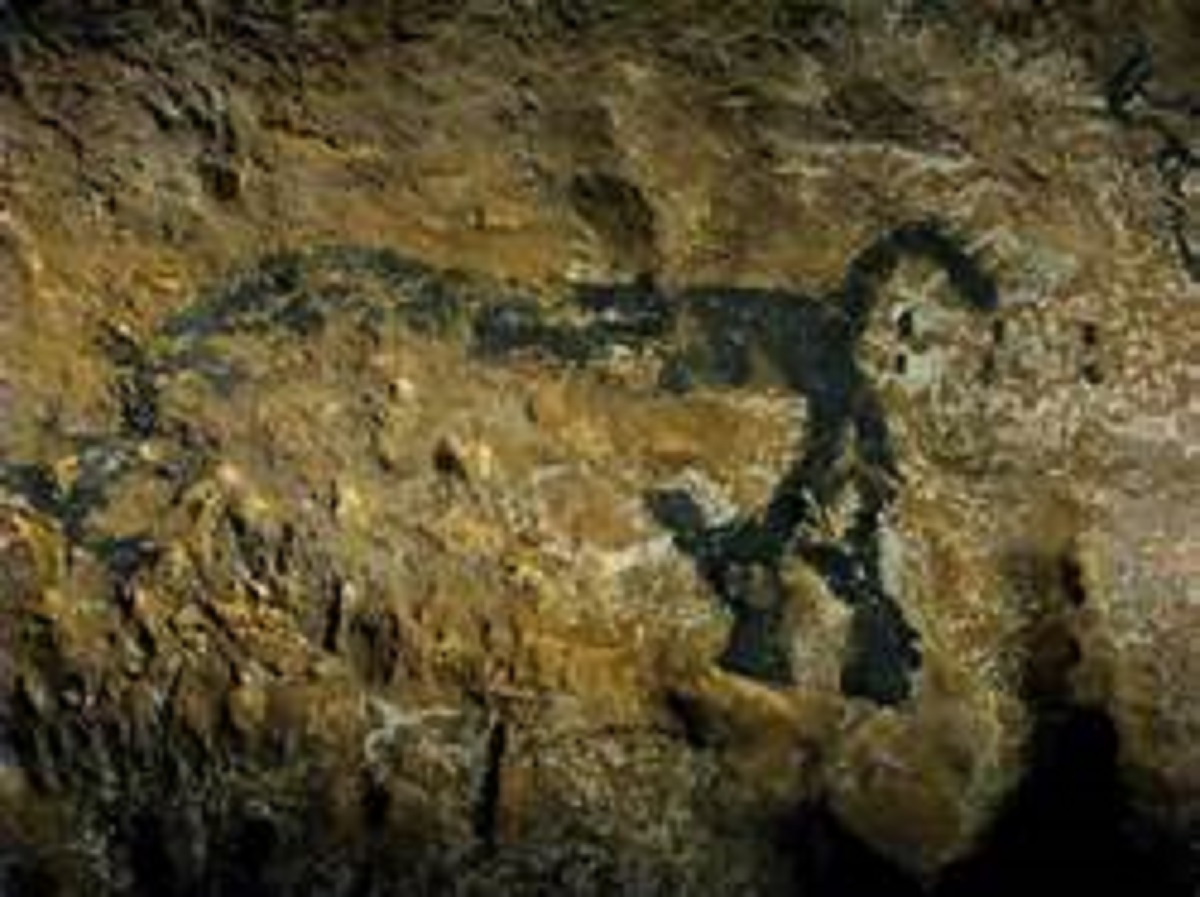
To the right, an obviously wounded bull, with an abdominal spear-wound and its intestines spilling out under pressure. Wounded animals showing spear/dart wounds are not uncommon in the Ice Age Art depicted in hundreds of caves and rock-shelters of Southern Europe: mostly in Spain, France, and some in Italy-all from the Late Paleolithic Era circa 12,000-40,000 BP (years before present).
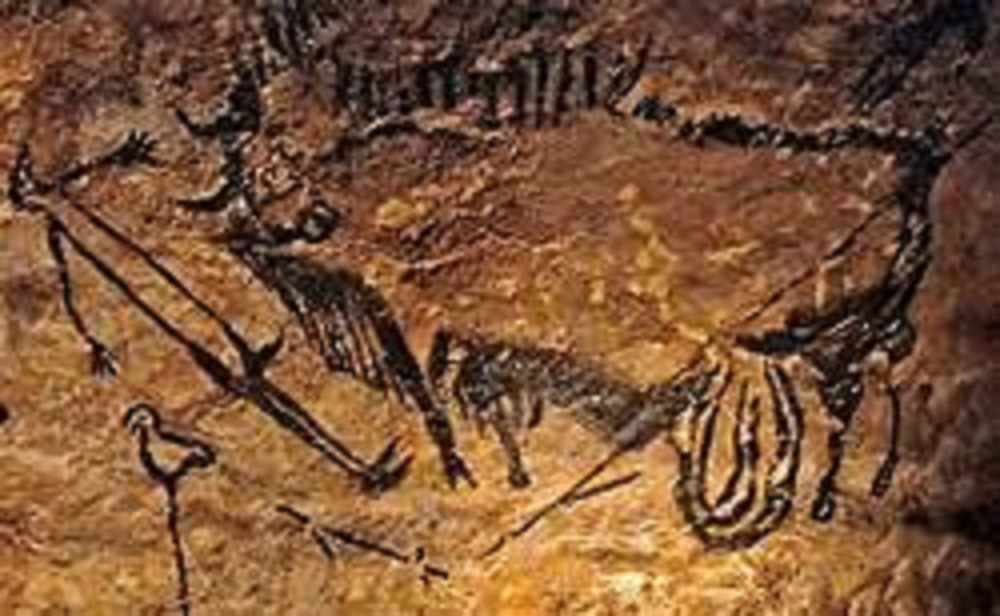
What is unique about this scene is the depiction of a human, most likely the hunter on his back, with his atl-atl (spear thrower) on the ground and a bird sitting on a stalk nearby (a common site-birds often eat the insects stirred up in front of herd animals as they graze along). In the very rare cases where humans are depicted at all, they are un-detailed stick figures such as this one.
This is a Paleolithic Hunter’s worst nightmare: a wounded animal-not fatally wounded, tail raised and charging. Instead of bleeding from its mouth and nose, incapacitated by a fatal heart-lung spear shot – this animal is angry, wounded, and as full of autonomic fight or flight adrenaline to defend itself-as the knocked back hunter is – depicted with an autonomic-scared-shitless erection: also a common response to sympathetic nervous system high arousal.
A powerful, frightening and realistic scene that an Ice Age hunter risks each time he would approach an animal of this size and power for a kill-shot to the heart-lung area. Only this time his atl-atl spear struck a foot or so behind the sweet-spot and hit the lower rear abdomen instead-worse than missing altogether.
This is the practical, realistic, interpretation of this scene from a hunter’s viewpoint as described in R. Dale Guthrie’s extensively researched tome:
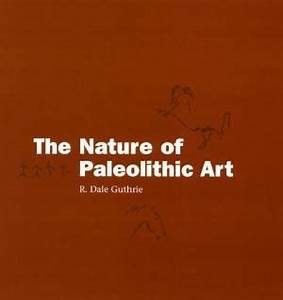 .
.
Guthrie, as I have written about before -HERE– is an academic, PhD biologist, specializing in Arctic and Ice Age mammals, an experienced hunter (residing in Alaska) and an artist himself of some skill. A rare combination, no doubt-that gives him a perspective not typical of Cave Art interpreters.
Nowadays, modern human hunters use high-powered rifles from a usually very safe distance to dispatch dangerous hunted animals such as moose or bears in northern climates. This Paleolithic hunting using a spear-thrower and long spears or shorter darts requires a much closer distance-within a dozen yards or so to be accurate enough to hit the heart-lung area of the front-lower abdomen to insure a fatal wound. The risk of a near miss is high. And the proximity required to kill these animals was incredibly risky-to put it bluntly-these guys had some serious balls to hunt such animals at such close range with primitive low-power weaponry. Incredible, to say the least.
It is no wonder the overwhelming majority of Paleolithic Cave Art is of these hunted animals, and the predators such as lions and bears one could encounter on the Paleolithic landscape.
Unfortunately from my perspective, interpreting these images for various sorts of spiritual, psychological, and/or magico-religious meanings, well beyond the practical hunting scene Guthrie describes, is the norm, and has been in archaeology-anthropology for the past century of academic study of Cave Art.
Let me illustrate a particular example.
Here’s a cropped image of the same painted scene from the Apse-Shaft at Lascaux that is shown on page 2 of an otherwise strictly scientific-empirical text: “Consciousness and the Brain” (an excellent treatise on modern neuroscience research into consciousness), by the accomplished French neuroscientist Stanislas DeHaene.
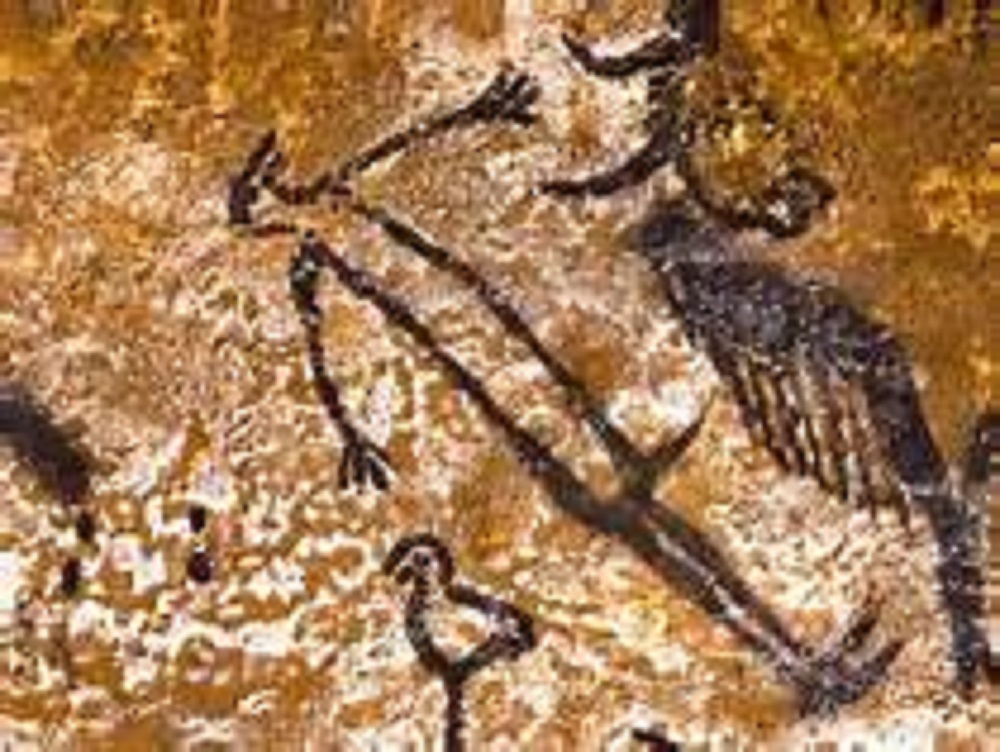
Notice you can’t see the rhinoceros defecating, nor the hunter’s atl-atl on the ground, nor the blatant gut-shot wound of the bull with the spear piercing his abdomen and intestines. The psycho-spiritual interpretation of this cropped scene, suggested by a sleep researcher, who is most likely not a hunter, nor a biologist, nor an archaeologist familiar with either Ice Age animals, or hunting, nor well-studied in Paleolithic Cave Art is as follows:
“The mind may fly while the body is inert. In this prehistoric drawing…a man lies supine. He is probably asleep and dreaming, as hinted by his strong erection, characteristic of the phase of rapid-eye-movement sleep, during which dreams are most vivid. Next to him, the artist painted a disemboweled bison and a bird. According to the sleep researcher Michel Jouvet, this may be the first depictions of a dreamer and his dream. In many cultures, the bird symbolizes the mind’s ability to fly away during dreams…”
Without the context of another typically wounded-animal depiction (the rhinoceros) and the atl-atl on the ground-implying along with the spear and spilling intestines that this hunting scene just happened, and the knowledge that birds perched in front of herd animals are common, and that erections are an autonomic response – not just during dreaming but during intense sympathetic fight or flight responses from abject fear, one can easily fit a pattern of psychological-spiritual meanings to what might have been a not uncommon hunting occurrence-a missed shot, an angry, wounded animal and a dangerously frightening situation. Additionally the cultures that employ birds or bats (Egyptian) as representing the mind or soul flying off in death or dreaming are 15,000 years in the future, wholly removed in time and circumstance from Paleolithic hunting times and life-ways. It is a bit of a stretch to assume the Ice Age people thought in the same terms as later agricultural, tribal, civilizations-but that is a largely unquestioned assumption on the part of most academics and the public at large: that magico-religious ideas are such an integral part of human nature-they must go back deep into prehistory: “humans always thought that way-just like we do”.
I contend that the only resemblance to a dream here is that this is as I said metaphorically – a Paleolithic hunter’s worst nightmare.
Here are some similar images of wounded animals from the Niaux Cave, also in SW France and dating to circa 17,000 BP.:
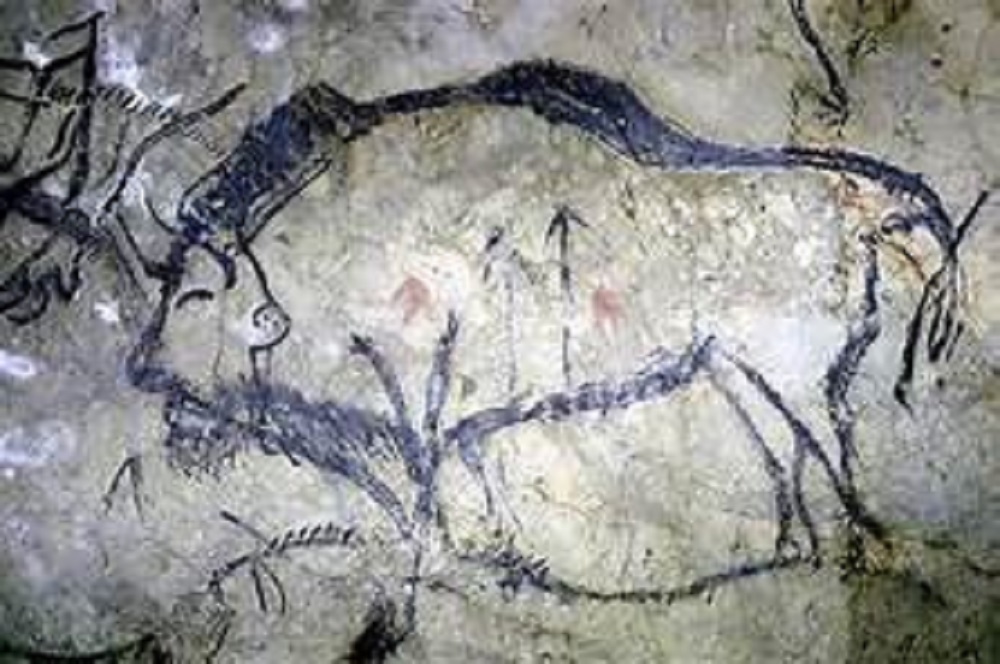
Note the spear points in the thoracic area-the heart-lung sweet spot for a fatal wound.
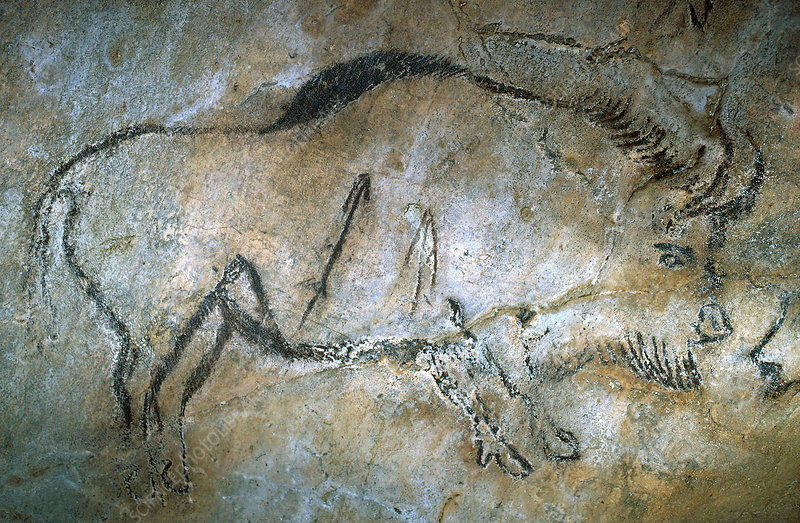
Speared bison.
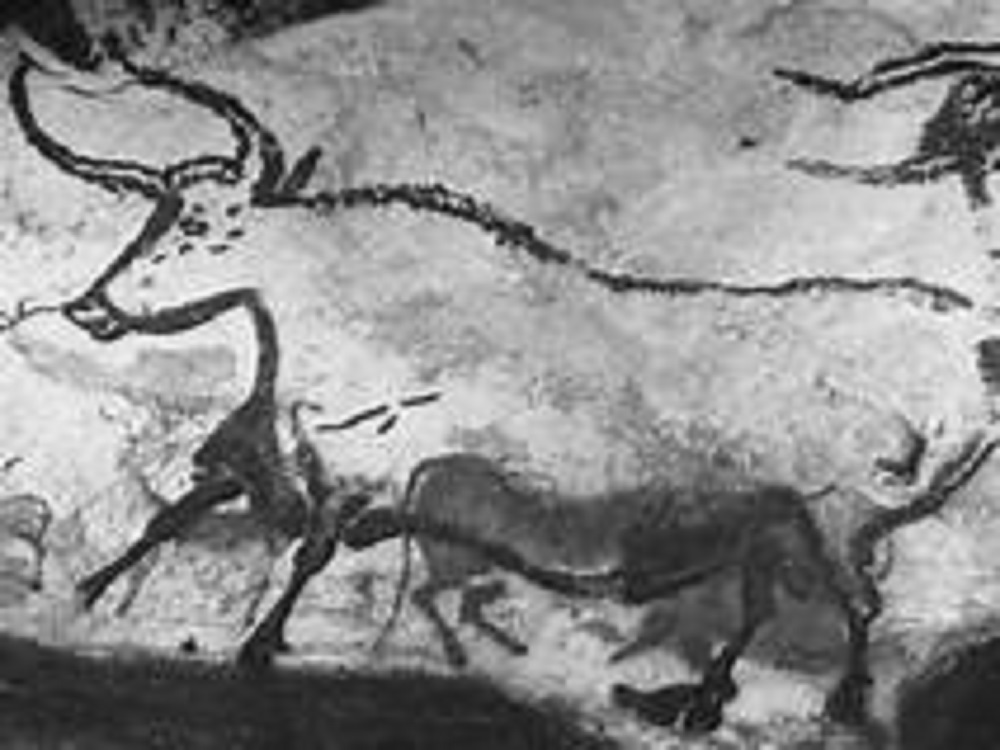
A speared aurochs with what may be blood coming from its mouth. A not uncommon site in Paleolithic Art is a wounded animal depicted with lung-blood coming from its mouth and nostrils. Again someone with a hunting background would understand this image. If you approach these images looking for spiritual meaning, with little background knowledge of what a typical hunting-wounded animal scene might contain, then you will miss the significance of the animals posture, defecation, a bird on the ground nearby, blood from the mouth and nostrils, an atl-atl and spears/darts which are regularly depicted.
Consider also that much of the interpretation of spiritual or magico-religious meaning is drawn from the best of the best images in Paleolithic Art: the excellent Paleo-artists whose work makes it into the coffee table art books. However, many of the depictions in the caves are poor quality, made by less-skilled artists and those dont make into the Art books or figure in the spiritual interpretations of Paleolithic Art. Two examples of horse depictions from Niaux will demonstrate what I mean:
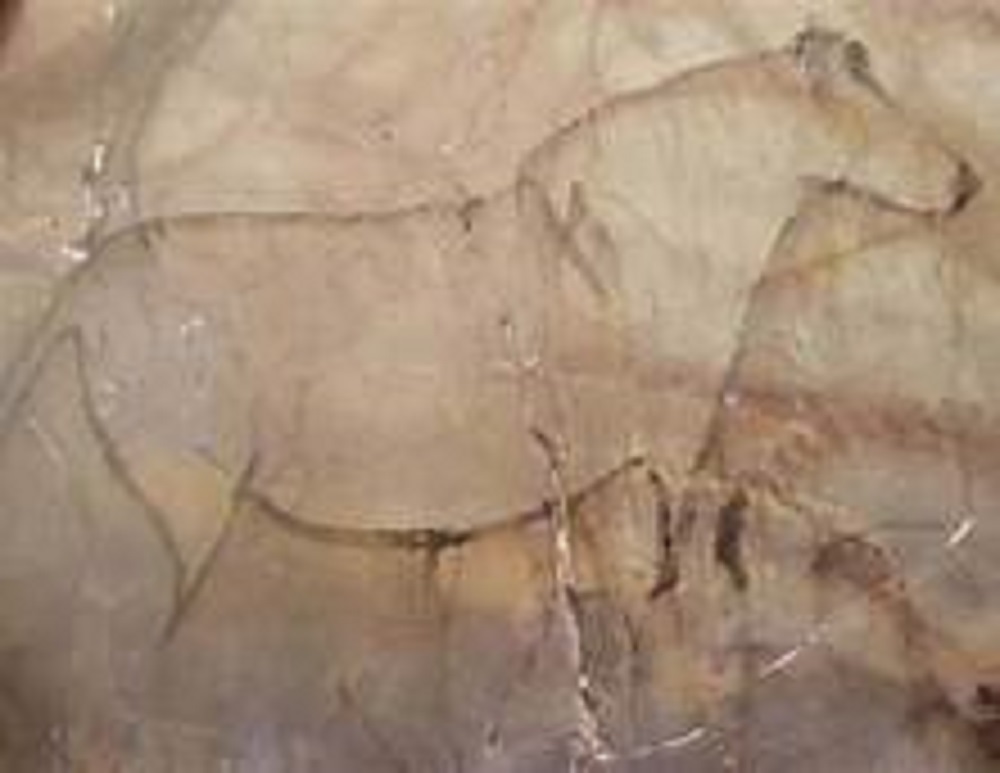
A low-skilled depiction.
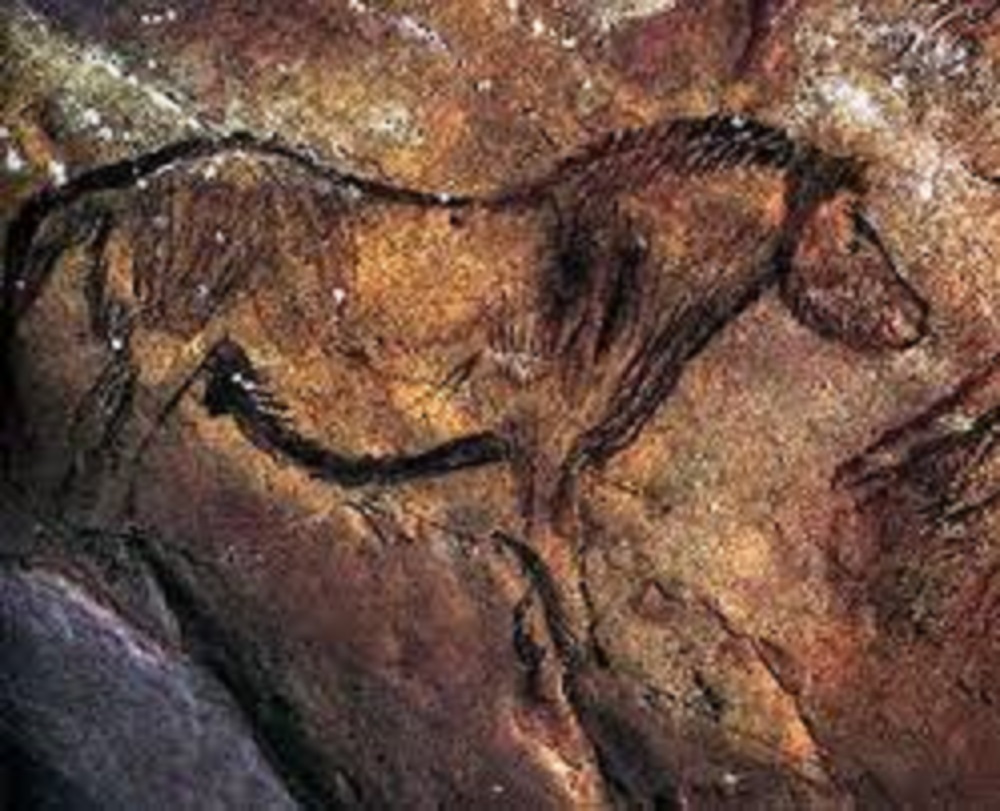
Rendition by a skilled artist. (note also the spear/dart in the thoracic region).
One of the widely accepted theories held by some prominent Cave Art interpreters is that the art was done by skilled shaman-artists who were depicting symbolic spiritual scenes meant to be seen in rituals attended by members of the Paleolithic band. Again a problem with that claim is that so much of the art is rather realistic animal depictions and hunting scenes. Additionally, much of the depictions are poorly drawn by low-skilled artists, often so sketchy and out of proportion that it is difficult to determine what the animal is. More importantly, much of the art is drawn in inaccessible parts of the caves, where it isnt possible to assemble a group to view the supposed shamanistic-spirtiual images.
Most importantly, there is no evidence whatsoever in the hundreds of caves across southern Europe, of any repeated occupation or group visitation-no trampled floors, multiple footprints, dropped artifacts, no soot on the walls and ceilings from the animal fat lamps used to light the caves. There are no sites which could be shown to be ritual gathering areas for shamanistic activities. Shamans are a comon occurrence in later hunter-gatherer societies and are depicted in Neolithic tribal art scenes 15,000 years in the future from Paleolithic Cave Art times. Also, out of the tens of thousands of images in the caves, only a handful could be interpreted as shamans-and they could well be hunters with animal disguises-also a not uncommon trick by hunters to approach their prey.
Here’s another comparison of what is typically presented in the coffee-table Paleo-Art books and what is also regularly depicted in the caves:
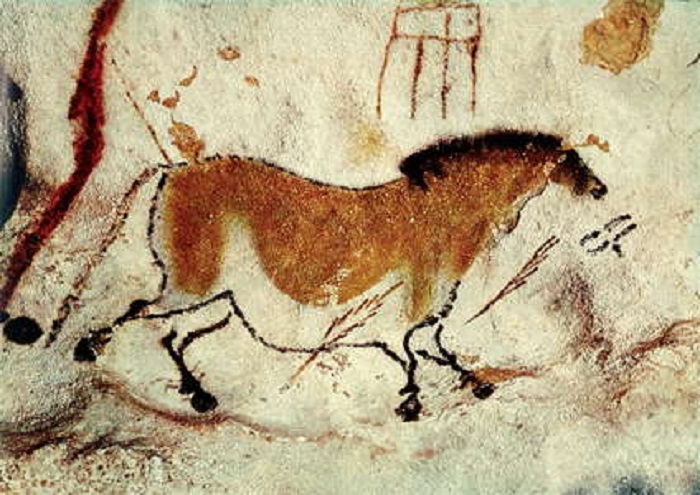
A skilled polychrome rendition of a horse with geometric designs above and in front, with what may be fletched atl-atl darts near the lower abdomen. This image from Lascaux appears regularly in published works as a typical example of Paleo-Art.
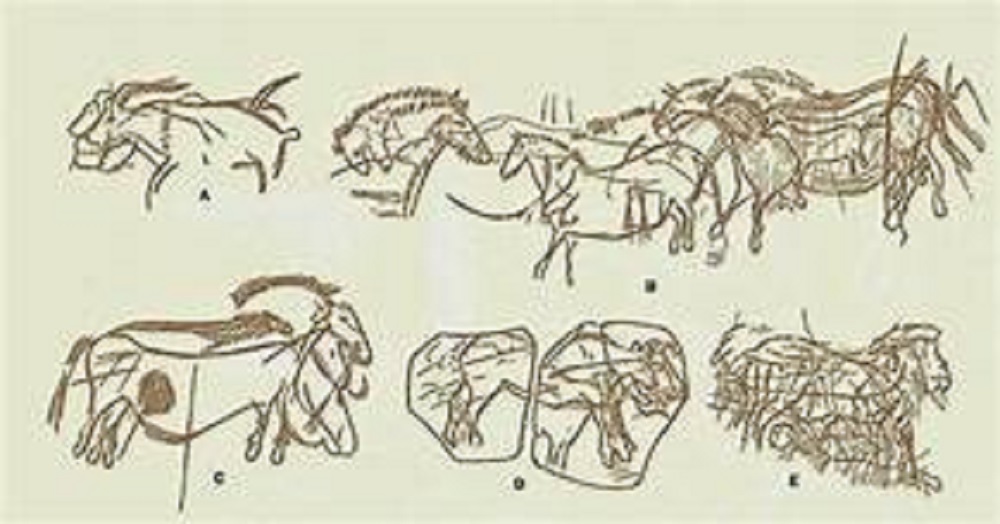
Here are more common examples of what the paintings, drawings, and engravings found in the caves look like-not as skillfully drawn, often incomplete and/or superimposed, and difficult to determine exactly the animal(s) depicted (taken from Guthrie’s line drawn copies).
And spinning a shamanistic interpretation to these very common examples is a bit of a stretch-and not even attempted. The “skilled (adult male) shaman artist” interpetation doesnt fit so well with these images-nor most of the depictions in the caves.
Much of this art, from the size and dimensions of the handprints and footprints in the caves, the skilled and un-skilled (beginners) images, the pre-occupation with hunted and dangerous animals, regular geometric doodling – and vulvae, lots of faceless female anatomy-all point to adolescent males and other children as the artists in the caves- NOT adult male skilled shaman artists.
Some further examples not often seen:
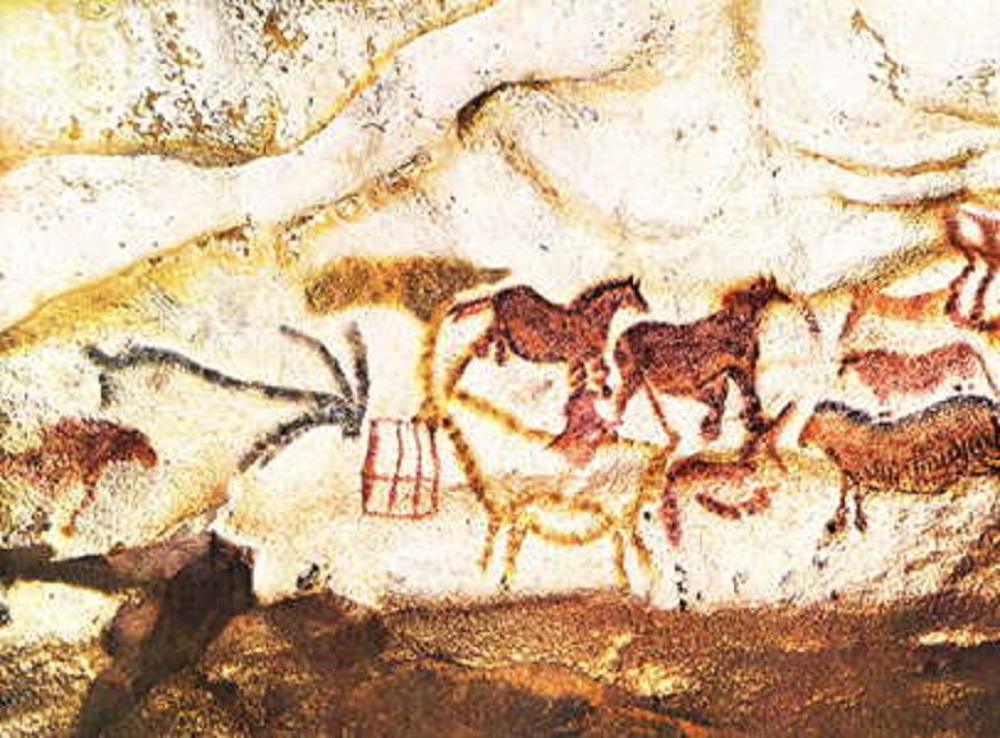
Depictions of Ibex and horses of various skill-levels-note the geometric box design.
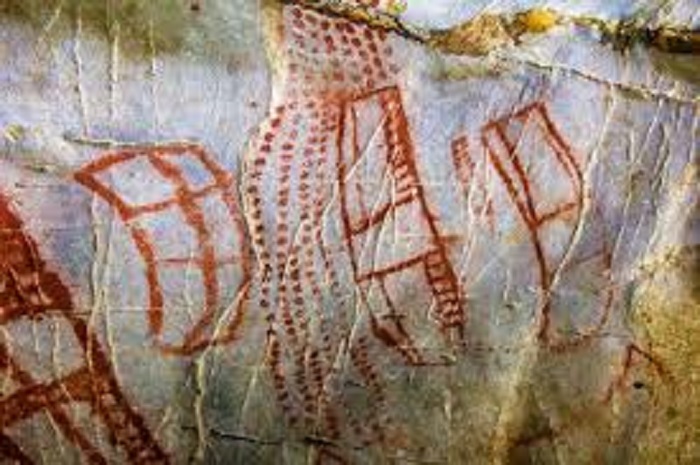
Boxes and dots are most common in the caves-“secret spiritual symbols”? or just doodling by less experienced artists? These are easy to draw, most children can make these when they cant draw much else very accurately.
There may be something rather important in here, to my mind about ALL the images, geometrics and the animal depictions, that is understandably never mentioned (at least I haven’t read any researchers make note of this-thus far): symmetry and equality.
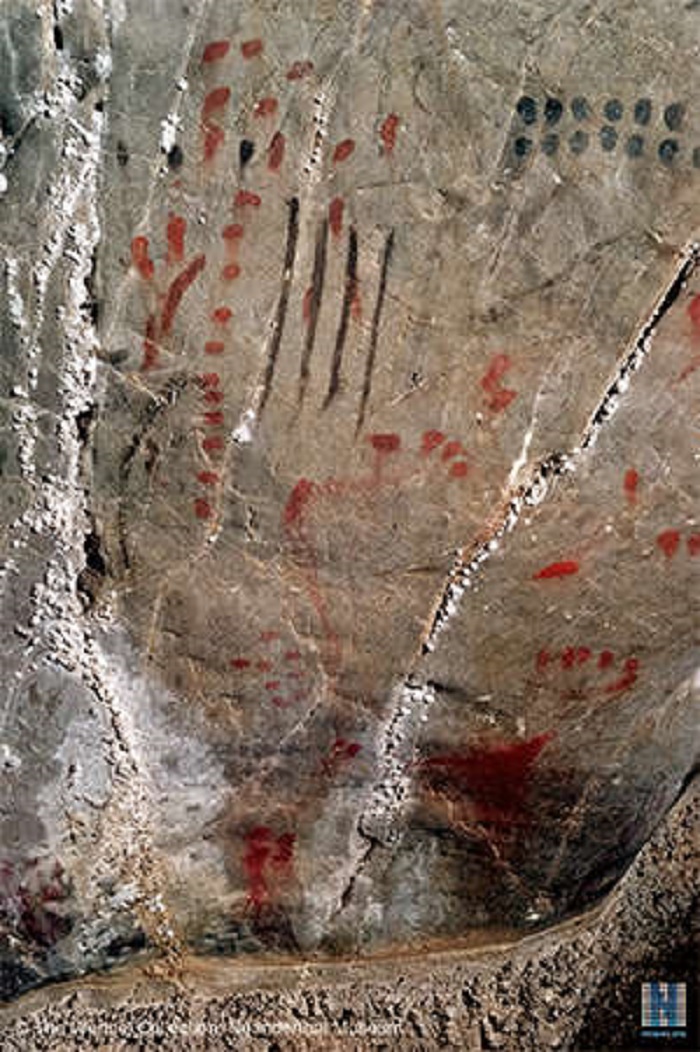
Whether its lines, boxes, or rows of dots-almost all show some facility (implicit or explicit) with equal spaces, equal elements (dots, lines, animals) often repeated in a consistent pattern…properly termed – translational symmetry.
Around this same time we find evidence of other deliberate translational symmetry in artifacts of various types:
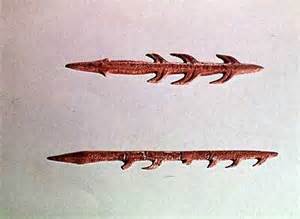
These fine harpoons; equal elements (the carved barbs), at equal spaces-repeated deliberately. This is not done by accident.
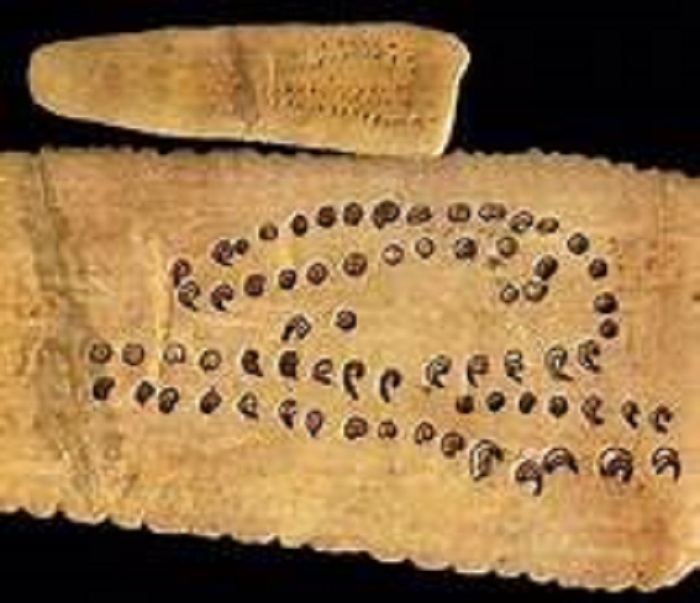
Engravings on bone-possible tally marks depicting moon phases or some repeating pattern – just for fun? More doodling? Or do the many examples of such engravings show some true symbolism-standing for some regular occurrence tracked in these precisely sized and spaced marks?
From a cognitive psychology standpoint, Im fascinated by what the human mind-brain is now capable of-deliberate symmetry in images, artifacts, and doodlings. We have bilateral symmetry (the first made by children and the most common) going back to around 500,000 years-nearly a half million years before Cave Art times as evidenced in this beautiful, skillfully made Late Acheulian Handaxe:
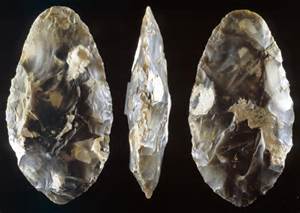
Bilateral symmetry-purposely produced. This is not by accident. One has to have at least an implicit sense of equality to make the edeges even and straight, and the sides the same thickness, and tapering equally to the same point. There has to be an implicit idea (at least) of an imaginary line down the middle to create the equal shaped left and right halves.
The first evidence of translational symmetry is this artifact from 70,000 years BP.
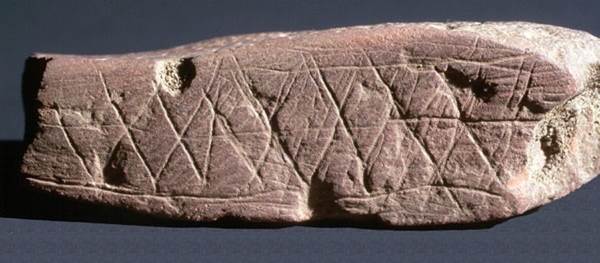
Not until over 400,000 years later, from the first bilaterally symmetric handaxes, do we see any evidence of a human being able to produce translational symmetry as in this engraved ochre piece from a South African cave.
And its not until 40,000 years after this one and only translational symmetry example that we see regularly produced art and artifacts with the characteristic pattern of repeated equal elements at repeated equal spacing:
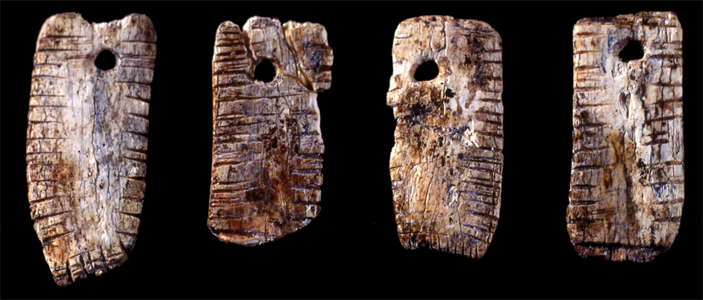
Engraved horse hyoid bones-Altamira Cave-Spain circa 16,000-20,000BP.
So regardless of the spiritual musings of standard Paleolithic Archaeology and Anthropology-seeing or trying to see some special magico-religious meaning in much of Paleo Art, the cognitive, conceptual abilities evidenced in the works themselves provide plenty of fascination and real meaning in what these people were capable of, on their way to becoming the type of cognitive creature that we are today.
(162)
